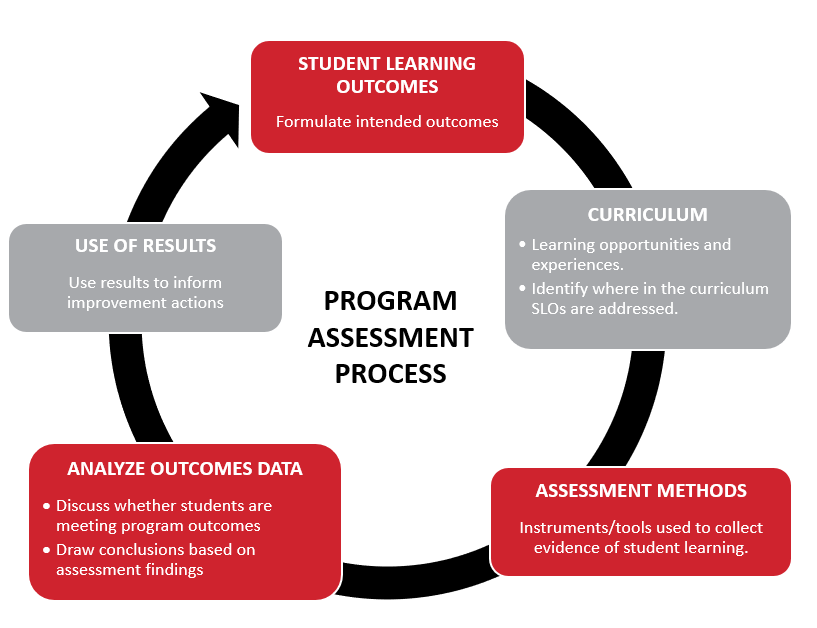Breadcrumb

Student Learning Outcomes Assessment
Program assessment planning and reporting are core to UCM's continuous improvement process. The university’s assessment cycle begins each year on August 1 and ends on September 30 of the following year. Academic programs and cocurricular units follow the same assessment planning and reporting timeline.
The university requires all academic programs (certificate, undergraduate, graduate) and cocurricular units to establish assessment plans that allow for systematic and ongoing collection and review of student learning data and use of evidence to inform curricular and pedagogical modifications. Assessment plans contain expected student learning outcomes and assessment measures.
Well-written student learning outcomes form a strong foundation for the program; they are student-centered, concise, achievable, and measurable. Program-specific student learning outcomes are published in each program’s catalog page.
All programs (curricula and coccuricular) are required to submit program assessment reports on an annual basis. These reports summarize student achievement of learning outcomes assessed over the previous academic year. The intentional use of assessment results to “close the loop” is a key step in our continuous improvement process. Programs are expected to specify actions taken or planned for each outcome in which a need for improvement was identified in assessment findings. These improvement actions address curricular and/or pedagogical modifications to enhance student learning.
Program Assessment Process
Assessment at UCM has a primary goal of using evidence to improve the student learning experience. Meaningful program assessment is intentional and iterative with careful attention given to student learning data and use of findings to inform improvements actions. UCM’s assessment process follows a five-step continuous improvement framework:
Specify Student learning outcomes
These are concrete statements that describe what students are expected to know, be able to do, and value after they have completed a program or participated in an activity/ experience. Program student learning outcomes derive from program mission and should be specific and measurable.
Provide Experience/Curriculum
Provide learning experiences that provide students opportunities to achieve specified learning outcomes. Determine in what ways required courses and/or experiences address student achievement of program learning outcomes. Consider creating a program curriculum map to make explicit the intersection of student learning outcomes and learning opportunities. A well-designed curriculum map helps identify the most appropriate assessment points, thus making your assessment process intentional and efficacious.
Select Assessment Methods
These are the instruments used to collect data to determine the extent to which students meet the learning outcomes assessed. Multiple measures for each learning outcome provide more reliable and meaningful information than using just one measure. At a minimum, one direct measure for each learning outcome is required.
- Direct measures use samples of student work products and involve actual performances or direct demonstration of student learning. Thus, direct measures provide the most reliable data that correlates with student achievement of the learning outcome being assessed. Examples of direct measures include capstone projects, exams, performance evaluations, theses, and comprehensive exams.
- Indirect measures rely on perceptions of student learning and involve gathering data through means other than student artifacts. Examples of indirect measures include surveys, focus groups, placement data, course evaluations, graduation rates, alumni surveys. These measures generally function as proxies of student learning.
- Grades are not a reliable measure of student learning as they do not provide meaningful information relative to student achievement of a given learning outcome. Moreover, grades are based on an individual student’s overall satisfaction of course requirements, which vary across instructors. Grades do not provide specific information concerning areas where students achieved well or concepts with which they struggled.
Specify performance/achievement targets for each measure. Performance targets indicate the desired level of student success relative to the learning outcome assessed. The targets are typically specified in terms of percentages (in relation to rubric ratings, scores, or level of proficiency). Performance targets should be reasonable for the program to adequately prepare students for success.
Analyze Outcomes Data
Once student achievement data are collected, the next step is to analyze and interpret the results. In other words, give meaning to the information collected and presented. The expectation is that program faculty as a whole analyze, discuss, and interpret student acheivement data. Assessment reports should not simply present undigested data; rather, they should clearly communicate findings relative to student achievement of the SLOs assessed.
Consider the results in the broader context of the program to determine whether students are meeting the learning outcomes assessed. In what areas did students do particularly well? What relative weaknesses in student performance were identified in the data? Make meaning of the data and draw conclusions based on assessment findings. Identify improvement actions in the context of the learning outcomes assessed. That is, recommendations for continuous improvement are rooted in assessment findings. Disseminate assessment findings to relevant stakeholders.
Use of Results
What are the next steps?
Make changes based on assessment findings (close the loop). Use of results to address gaps in student achievement is the most important step in the assessment process. Create action plans for each outcome in which a need for improvement was identified in assessment findings. Actions may include revising SLOs, refining the measures used or trying different assessment tools, enhancing certain areas of course material, as well as review solutions that provide students opportunities for practice and preparation.
If performance targets were met, describe program efforts to further enhance or sustain student achievement of the relevant learning outcomes.

Program Assessment Timeline
|
Deadline |
Activity |
|
September 30 |
Complete the Student Learning Outcomes (SLO) assessment report for previous academic year. This includes:
Complete and submit the program Assessment plan for the current academic year.
|
|
October 31 |
|
|
March 1 |
FSUAC completes rubric-based peer review of a sample of SLO assessment reports and provides feedback for improvement to reviewed academic programs. |
Please contact the university assessment office at assessment@ucmo.edu with any questions.
University Assessment
Dr. Josiah Nyangau
Assistant Vice Provost, Assessment and Planning
Admin 104
Tel: (660) 543-8855








